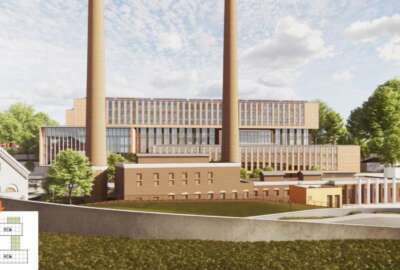

The Homeland Security Department's headquarters project might be one of the longest running construction programs in government history. Planning started more than...
Best listening experience is on Chrome, Firefox or Safari. Subscribe to Federal Drive’s daily audio interviews on Apple Podcasts or PodcastOne.
The Homeland Security Department’s headquarters project might be one of the longest running construction programs in government history. Planning started more than 17 years ago. And the latest estimates pegged the completion date now at 2027, another five years. Now the Government Accountability Office says the latest cost and schedule estimates lack detail enough to know whether they’re reliable. The Federal Drive with Tom Temin gets more from the GAO’s director for homeland security and justice issues, Chris Currie.
Interview transcript:
Tom Temin: And the latest cost estimate from DHS I guess, and also the General Services Administration, that latest report is required by law. Correct?
Chris Currie: Exactly right. The law was passed way back in 2015, for them to update the cost and schedule estimates that we had recommended. It’s very late and just was issued recently. So this is why we took a look at it.
Tom Temin: Wow. And the report itself had some shortcomings. And we’ll get to the larger project. But the report itself, you weren’t all that pleased with?
Chris Currie: Well, the problem in this project is over the years, there’s been a number of resets, which have kind of required them to redo the cost and schedule estimates several times. And then construction progress would overtake those costs and schedule estimates. And so then they do an update, and everything would reset and change. And so this has been a recurring event over time. So this most recent update by DHS did not provide new costs and schedule estimates, mainly because GSA was still working on some of those things. And they were resetting again, the construction plans at the campus itself. So as you said, the new estimate for completion is 2027. They started planning this in 2005. So we’re over 20 years, and $2.8 billion, since the original plans for this project was started.
Tom Temin: And for listeners who might have been in high school when this started, this is the St. Elizabeth’s Hospital campus in southeast Washington, DC. And there has been some progress. The Coast Guard has a spiffy building there, there is a campus. And DHS itself has a smallish headquarters for some components. So it’s not as if nothing has happened for that 2.8 billion.
Chris Currie: Right. But the project has been incredibly complicated, as you know, and it was picked at the time because it was available. And there was the amount of space that DHS initially thought it needed to consolidate its headquarters components. But essentially, what’s happened is, it’s been a combination of having to build new buildings on a very difficult historic site with a lot of rules and regulations behind how they could build, for example, the Coast Guard headquarters could only have been built at a certain height because views to the district and DC couldn’t be blocked. Same is true with some of the buildings that are historic buildings which could not be torn down. So essentially, they had to get these things, you know, kind of like This Old House, down to the bare bones, and completely redo them. So they cost way more than they thought and took way longer to build. And that’s what’s caused a number of the delays.
Tom Temin: And at the moment, I guess the main construction project is the Cybersecurity and Infrastructure Security Agency?
Chris Currie: Right, there’s a couple big projects that are in planning and construction or almost at construction right now. One is the cybersecurity agency building, which is going to be completely new construction, like the Coast Guard building. But again, it’s being built on a difficult sloping site that requires a lot of work, a lot of cost to get the site ready. And then actual construction, and also having to work around restoration of certain facilities, for example, there’s a power generation facility there that cannot be destroyed because of historic purposes that they have to use and renovate in accordance with, you know, with the needs of these brand new facilities. So if you think about it’s like the combination of these very modern, highly secure office buildings, and then, you know, these brick structures that are over 100 years old.
Tom Temin: Yeah, I guess it seemed like a good idea at the time. We’re speaking with Chris Currie, director of homeland security and justice issues at the GAO. And has part of the problem also been stop and go funding from Congress? Because if you can’t plan beyond the funding you have, and if the funding doesn’t come through, and then a program gets delayed, costs never seem to go down in that situation.
Chris Currie: The funding situation on this project has been very interesting for a couple of reasons. I mean, one is you have two agencies. So the funding goes through both GSA and DHS in different pots. And so it requires the coordination of that funding but also requires both agencies to get the right funding they need to do the project. However, what’s happened over the years is because there have been problems with the cost of schedule estimation, and a lot of questions in Congress. At different times, funding has not either not been provided or has been restricted. For example, for several years, GSA was provided none of its requested funding and DHS was provided its funding. So they’ve had to cobble together what funding they have to build out the project. And I think because of that, there’s been a lot of changes and delays over time. For example, there was a point in time when I think they were going to hopefully do some of this construction concurrently and build all these buildings at the same time. But because of the funding problems, they were only able to focus on one building at a time, and then move to the next building. And then of course, by doing that, years pass, needs change, plans change. Other DHS components may have signed leases throughout the national capital region and don’t need to come there anymore. And so the plans reset. So it’s kind of like a chicken and egg thing. It just keeps changing over time. And then that affects the funding and the timeframes.
Tom Temin: All right, getting back to your most recent report then, that you felt that it could not really be verified what was in there, because it had not been updated fully. And there were missing facts, any recommendations? And where does it all go from here. As you said, there’s one building under construction, a good looking place too, it’s a real piece of architecture. But what else?
Chris Currie: Well, in government, the way this is supposed to work, and the way we want it to work is that you develop a cost and a schedule estimate as accurately as possible. And then you stick to that. Now, it’s not uncommon that that would change or you go above cost, but you stick to the plan. I think the challenge here is the plans have changed so many times that they’re just not updating the cost and schedule estimates. So right now, the big projects coming up in the next few years are the, as you said, the building of the cybersecurity agency. And then there’s another new building on the campus that’s going to house parts of immigration, customs enforcement, and then customs and border protection as well. So these two big buildings, all the site work and the construction work need to be incorporated into the overall cost and schedule estimate to build out the rest of the campus, even though they say they hope to do that by 2027. That’s not really all down on paper. So, you know, I’m not very optimistic that they’re going to be able to stick to that without seeing the details of the plan. The other thing Tom, I wanted to mention, it’s critical. And you know, we just had two and a half years of a pandemic, you know, the whole landscape of the workforce at DHS, and the national capital region is changed too. I mean, they have 34,000 people in the national capital region. So 148 lease locations, 118 federal locations, just in the NCR. And so St. Elizabeth’s is now just a component of their overall space plan in the region. That’s changed in the last couple years. So that’s just part of the picture they have to come up with with overall workforce plan.
Tom Temin: And do you get the sense? Or have they had the experience that contractors may not want to necessarily bid on these projects? With so much uncertainty?
Chris Currie: Right, it’s very difficult to think about it, even if there’s a plan, given the past history of plan changes and additions and funding uncertainties, I think it’s a very risky thing to bid on if you’re a contractor, and that certainly factors in. Also I mean, you know, like any contractor, they’re looking at what’s actually being done and the uncertainties. And so, you know, particularly the part of this, that’s the restoration of the old buildings is, you know, there’s going to be cost that are unexpected and unplanned for. So it’s probably not the most enticing contract to bid on if you’re a construction company.
Tom Temin: And one of the attractions of Southeast was that perhaps it could draw some urban renewal surrounding DHS, because of how many people would be working there and traveling there every day. Has any of that materialized?
Chris Currie: You know, we haven’t really done any analysis of the surrounding area. But I can just tell you, having been there several times and looking at the development, I think the way the campus is developed, it’s really kind of an insulated campus. For example, to get to the core of it requires going through one or several security gates, getting to a parking deck, then transferring to another location. So while I think the original design of the core of the campus was to be walkable, and I think between some of the buildings there right now, the surrounding space is very large. So the idea that people were just going to come and go out of the campus, it’s not easy to get in and out of the campus. So I’m not sure that’s really played out the way everyone expected it to.
Tom Temin: Yeah, this is definitely not Washington’s version of Rockefeller Center, is it?
Chris Currie: No, it’s not. Part of this is security and buffer zones. I mean, there’s some security benefits to St. Elizabeth too because it’s not easy to get in and out of the campus. So that was also part of the justification of having DHS be there.
Tom Temin: Alright, so any recommendations at this point?
Chris Currie: Well, our recommendations from our 2014 report on the updated cost and schedule estimates still stand and they’re still open. And because we don’t think those have been implemented yet. We still think they need to do that, even though they are hopefully kind of toward the tail end of completing this project. My concern is even though on paper, they’re just saying they’re going to complete a few more buildings and then be done, given the track record that could take a lot longer than they’re saying, and also, I think it’s important that they’ve just put down on paper, what their plans are for this campus versus the rest of the locations and the workforce around the rest of the capital region, and just hopefully, figure that out and complete this project and put this to bed finally.
Tom Temin: Chris Currie is director of homeland security and justice issues at the Government Accountability Office.
Copyright © 2025 Federal News Network. All rights reserved. This website is not intended for users located within the European Economic Area.
Tom Temin is host of the Federal Drive and has been providing insight on federal technology and management issues for more than 30 years.
Follow @tteminWFED



